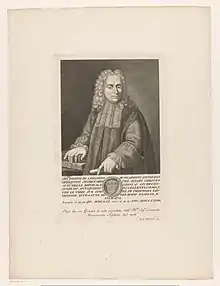Filippo Buonarroti
Filippo Buonarroti (Florence, 18 November 1661 — 10 December 1733),[1] the great-grandnephew of Michelangelo Buonarroti, was an Italian official at the court of Cosimo III, Grand Duke of Tuscany and an antiquarian, whose Etruscan studies, among the earliest in that field, inspired Antonio Francesco Gori. The Etruscan art and antiquities in the family palazzo-museum of Florence, Casa Buonarroti, are his contribution to the artistic-intellectual memorial to the Buonarroti.[2]
- See also Philippe Buonarroti (1761–1837), expatriate radical journalist.
Filippo Buonarroti | |
|---|---|
 | |
| Born | 18 November 1661 Florence, Grand Duchy of Tuscany |
| Died | 10 December 1733 Florence, Grand Duchy of Tuscany |
| Occupation | Antiquarian, numismatist, archaeologist |
| Parent(s) | Leonardo Buonarroti and Ginevra Buonarroti (née Martellini) |
Biography
Filippo Buonarroti pursued studies in law and exercised an early scientific curiosity.
His early iconographic study of Imperial bronze coins and medals of Roman emperors in the collection of Cardinal Gasparo di Carpegna,[3] which he dedicated to Cosimo III, made his reputation as a scholar; it was published as Osservazioni Istoriche sopra alcuni medaglioni antichi all'Altezza Serenissima di Cosimo III Granduca di Toscana[4] (Rome 1698) and contained thirty full-page engraved plates by Francesco Andreoni, all but one of coins. The books had its origins in Buonarroti's years 1684 to 1699 in Rome in the familia of Cardinal Carpegna, whom he served as secretary, conservator of collections and librarian.[5]
.JPG.webp)
In 1699 Cosimo III recalled him to Tuscany and employed him as Auditore delle Riformagioni, as minister of the Pratica of Pistoia, secretary of the Florentine Pratica and as a participant in a newly organised committee for jurisdictional affairs. In 1700 he was made a senator, a purely honorary role in the Medici Grand Duchy.
He is remembered most for his pioneering study of gold glass vessel bottoms used as grave-makers in the Catacombs of Rome, Osservazioni sopra alcuni frammenti di vasi antichi di vetro ornate di figure trovati nei cimiteri di Roma (1716),[6] in which he made the extraordinary, almost proto-Romantic assertion that the aesthetic crudity of early Christian art, often remarked by connoisseurs of Roman arts, had served to intensify the piety of the worshipper, an early expression of feeling for primitive art.[7]
He updated and edited Thomas Dempster's De Etruria regali (in eight volumes, 1723), a classic study of Etruscan art that had been written a century earlier by the Scottish scholar who was based in Pisa.[8] Buonarroti provided some of the engraved illustrations and in 1724 he published a commentary on the work.
Notes
- Dates from Sistema Informatico Archivio di Stato di Firenze; he was the son of Leonardo Buonarroti and his wife Ginevra Martellini.
- In the catalogue to the exhibition in Casa Buonarroti, Filippo Buonarroti e la cultura antiquaria sotto gli ultimi Medici (Florence, Cantini, 1986), the curator Daniela Gallo assumes that Filippo must have collected most of the Etruscan art in the Buonarroti collection.
- Gasparo dei conti di Carpegna (1625-1714), titular archbishop of Nicea, a functionary of the Papal curia, was made a cardinal in 1670 (Salvador Miranda, "Cardinals of the Holy Roman Church").
- "Observations on some ancient medalions [dedicated] to His Most Serene Highness, Cosimo III, Grand Duke of Tuscany" (On-line catalogue entry).
- On-line Informatico Archivio di Stato di Firenze.
- Observations on some fragments of antique glass vases decorated with figures, found in the cemeteries of Rome
- James Hall, "Michelangelo and the Etruscans", New York Review of Books 53.17 · 2 November 2006
- See Seduzione etrusca : dai segreti di Holkham Hall alle meraviglie del British Museum, a cura di Palolo Bruschetti, Bruno Gialluca, Paolo Giulierini, Suzanne Reynolds, Judith Swaddling, Milan, Skira, 2014.
Further reading
- Fishman, W. J. "Filippo Buonarroti 1761-1837." History Today (March 1967), Vol. 17 Issue 3, pp 170-179 online.
External links
- Parise, Nicola (1972). "BUONARROTI, Filippo". Dizionario Biografico degli Italiani, Volume 15: Buffoli–Caccianemici (in Italian). Rome: Istituto dell'Enciclopedia Italiana. ISBN 978-8-81200032-6.